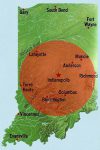24 Oct The Difference Between Sandblasting and Soda Blasting in Indianapolis, IN
Sandblasting and soda blasting are two types of methods that are used to strip paint or finish from substrates (often on machinery or buildings). Both of them involve the use of abrasive materials as the primary medium for the stripping, but there are some key differences to be aware of.
Let’s take a closer look at sandblasting and soda blasting and the differences between the two methods.
What is sandblasting?
Sandblasting in Indianapolis, IN is often used as a catch-all term for blasting with abrasive media, which would include soda blasting, but it is important to note that it is its own category of abrasive blasting.
Sandblasting is ideally used for industrial applications. It is particularly effective at removing rust—more so than other types of abrasive media blasting, including soda blasting. It’s also quicker to clean up than soda blasting or other forms of abrasive media blasting.
There are some drawbacks to consider. Sandblasting is generally not recommended for softer materials such as plastics, wood or glass. It can create an elevated level of heat through friction, and will not sanitize or deodorize materials (like soda blasting does). In addition, the infiltration of sand particles can lead to a condition called silicosis.
The good news is that sandblasting is quick and cost-effective, and there are more materials that can be used than just sand.
What is soda blasting?
Soda blasting is a newer type of abrasive blasting featuring the use of sodium bicarbonate, more colloquially known as baking soda. In this process, a specially granulated version of the substance is shot at high pressures onto a surface to remove contaminants or make the surface smoother.
There are a variety of benefits of soda blasting that have helped encourage its rise in popularity. For example, it is very environmentally friendly, as the material is biodegradable and will not build up in soil or residential areas. It is a much gentler process than sandblasting, which means it can be used on a wider variety of materials that sandblasting cannot, including plastics and wood. Unlike sandblasting,it does not produce any excess heat, which removes a safety hazard. It is non-toxic and water-soluble, cleans mold, deodorizes smoke fires, prevents rusting and does not warp or pit metal surfaces. Plus, it will remove grease and paint at up to 15 times the speed you’d achieve with industrial hydro-blasting.
Even with all these benefits, soda blasting is only slightly more expensive than sandblasting. That doesn’t mean it’s completely without its drawbacks, though. There are some circumstances in which soda blasting can result in a white film being left behind on the surface that’s being cleaned. But most of the other negative side effects associated with sandblasting are not a concern in the soda blasting process.
For more information about sandblasting or the relatively new technology of soda blasting in Indianapolis, IN and other things you should know about these processes, we encourage you to contact the team at Knauss Property Services, LLC today.





Sorry, the comment form is closed at this time.